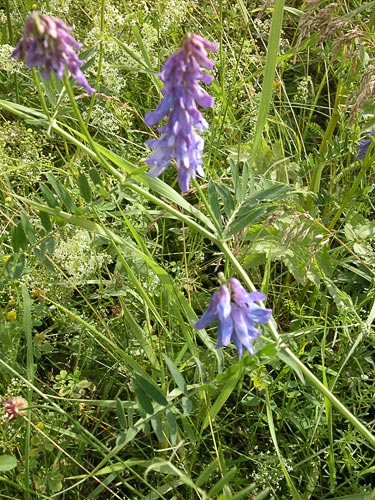Weeds
Vicia cracca L. - Tufted Vetch, Bird Vetch
Systematic position.
Family Fabaceae, genus Vicia L.Synonyms.
V. macrophylla (Maxim.) B. Fedtsch., V. lilacina sensu B. Fedtsch.Biological group.
Perennial ratoon plant.Morphology and biology.
Stem to 150 cm long. Whole plant is glabrous or slightly pubescence; rhizome with rather long underground branches. Stem usually branchy, scandent, ribbed; leaf axis ended with branched tendrils. Stipules 6-10 mm in length, half-sagittate at lower leaves, linear and single at upper leaves, sometimes with 1-2 teeth (var. dahurica Turcz.). Folioles in 6-10 (12) pairs, linear-lanceolate or oblong-lanceolate, 1.5-3 cm in length, 1-4 cm in width, sometimes grayish because of thick hairs (var. canescens Maxim.). The first 2-3 leaves scale-shaped. Flowers 10-13 mm in length; calyx short, campaniform; lower teeth considerably longer than upper ones, but shorter than tube. Corolla lilac or violet, very rarely white (var. albiflora Trautv.); limb of flag equal in length to claw; carina and wings considerably shorter than flag. Beans are oblong-rhombic, compact, glabrous, 16.0-25.0 x 4.3-5.5 mm. Seeds are spherical, brown or grayish-green, almost black, sometimes mottled or marble with black spots of different shape and size, mat, with smooth surface, 2-3 mm in diameter. There are 4-8 seeds. Seed hilum envelops 1/4 to 1/3 of seed. Mass of 1000 seeds is about 10 g. Productivity to 5000 seeds. The seeds germinate from depth to 12 cm. Shoots from the seeds and ratoons appear in April - May. Flowering in May - July.Distribution.
Europe, Asia; North America (adventive).Ecology.
The species inhabits meadows, fields, pastures, gardens and kitchen-gardens, preferring humid places. In zone of irrigate agriculture it grows on fields with grain and oil-yielding crops, grasses, along banks of canals and irrigation canals. Seeds germinate from depth to 12 cm. The plant prefers soils having no gley or being poorly gleyey.Economic significance.
V. cracca litters grain and tilled crops. Control measures include timely and qualitative cultivation of soil with early autumn stubbling of soil by use of moldboard hoeing plough with subsequent deep plowing; and in spring deep pre-sowing treatment of soil by cultivator or layer cultivation of the soil.Related references:
Artokhin K.S. 2004. Atlas of weed plants. Rostov-na-Donu. 144 p. (in Russian).Bazdyrev G.I., Zotov L.I., Polin V.D. 2004. Weed plants and their control in modern agriculture. Moscow: MSKHA , 288 p. (in Russian).
Komarov V.L., ed. 1948. Flora of the USSR. V. 13. Moscow & Leningrad: AN SSSR, 588 p. (in Russian).
Ramenskii L.G., Tsatsenkin I.A., Chizhikov O.N., Antipin N.A. 1956. Ecological evaluation of the fodder lands by vegetation cover. Moscow: Selkhozgiz, 472 p.
(in Russian).


